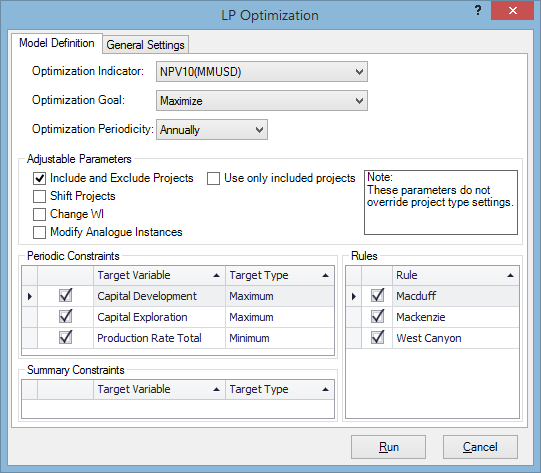LP Model Definition tab
This tab is used to define parameters for portfolio optimization.

The Optimization Indicator list contains all summary variables from configuration settings, whose aggregation types are 'Sum' (see Summary Variables), since the LP Optimizer can only solve linear equations. This indicator is the basis for the optimization process. Only one indicator at a time can be used for optimization.
The Optimization Goal list contains functions which will be used for optimization:
- Minimize: The algorithm will search for the smallest value of the optimization indicator.
- Maximize: The algorithm will search for the largest value of the optimization indicator.
The Optimization Periodicity field defines the step for the Shift Projects field parameter (see below). It should be set to Annually wherever possible as this increases the speed and reduces memory consumption of the optimizer.
The Adjustable Parameters section tells the algorithm which actions can be performed to produce the desirable results; all options are described in the table below.
Note: These options take into account project type settings. For example, if a project belongs to a non-divestible type, it will not be excluded even if the Include and Exclude Projects box is checked.
| Option | Description |
|---|---|
| Include and Exclude Projects |
If you check this box, projects will be included or excluded to obtain the best results. To use only currently included projects, check the Use only included projects box. Note: If an MEG is included in optimization and the Include and Exclude Projects box is unchecked, only the previously included project from that MEG will be considered for optimization. If this box is checked, a different project from that MEG may be included. For more information, see Mutually Exclusive Groups. |
| Shift Projects | If you check this box, the Minimum Step (months) field will become active where you can specify the minimal number of months by which projects can be shifted. |
| Change WI | If you check this box, the Minimum Step (%) field will become active. Here you can specify the increment by which your working interest share can be changed. |
| Modify Analogue Instances | If you check this box, the number of instances in projects with analogues will be modified. |
The Periodic Constraints table determines which periodic variable targets will be considered during optimization. The targets are set up in the configuration settings (see Periodic Variables) and their values are entered on the Set Targets tab (see Targets). The Target Type column is populated automatically and cannot be edited. To include a target into optimization, check the box next to its name.
The Summary Constraints table determines which summary variable targets will be considered during optimization. The targets are set up in the configuration settings (see Summary Variables) and their values are entered on the Set Targets tab (see Targets). Constraint types and the penalty function are the same as in the Target Constraints table.
In the Rules table, select business rules which the optimized portfolio must satisfy. For information about rules, see Business rules.
